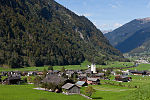Gandstock
Canton of Glarus geography stubsMountains of SwitzerlandMountains of the AlpsMountains of the canton of GlarusTwo-thousanders of Switzerland

The Gandstock (2,315 m) is a mountain of the Glarus Alps, located south-east of Schwanden in the canton of Glarus. It lies at the northern end of the range separating the main Linth valley from the Sernftal, north of the Kärpf. On its west side is located the Garichtisee.
Excerpt from the Wikipedia article Gandstock (License: CC BY-SA 3.0, Authors, Images).Gandstock
Glarus Süd
Geographical coordinates (GPS) Address Nearby Places Show on map
Geographical coordinates (GPS)
| Latitude | Longitude |
|---|---|
| N 46.929166666667 ° | E 9.1169444444444 ° |
Address
Blangg
8767 Glarus Süd
Glarus, Switzerland
Open on Google Maps








